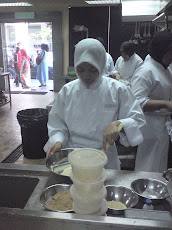Introduction
In the second our experiment, our group have given a task to varying how many strokes kneading in the bread recipe. We just need to follow as the basic formula of the bread in the amount of ingredient and different procedure. As the result we can see in the table.
Basic formula – bread
Ingredient
7g (1Pkg) yeast, dry
118ml (1/2c) Water at 35ºC
4g (1 tsp) Shortening
6g (1 ½ tsp) sugar
3g (½ tsp) salt
200g (1 7/8 c) All purpose flour
Method – 100 strokes kneading
1. Prepare the mise en place and open the oven to 220°C.
2. Add yeast to 59 ml water and barely melt shortening.
3. Sugar, salt and remaining water in mixing bowl, add shortening and yeast water, and stir.
4. Then add to mixer and add slowly flour until smooth.
5. After that, take out from mixer and knead until 100.
6. Very lightly coat dough with oil and cover with aluminum foil until the dough is double size.
7. Then punch the dough and shape into loaf.
8. Return to water bath and with until double in volume.
9. Lastly, bake 15 minutes for 220°C.
Method – 200 strokes kneading
1. Prepare the mise en place and open the oven to 220°C.
2. Add yeast to 59 ml water and barely melt shortening.
3. Sugar, salt and remaining water in mixing bowl, add shortening and yeast water, and stir.
4. Then add to mixer and add slowly flour until smooth.
5. After that, take out from mixer and knead until 200.
6. Very lightly coat dough with oil and cover with aluminum foil until the dough is double size.
7. Then punch the dough and shape into loaf.
8. Return to water bath and with until double in volume.
9. Lastly, bake 15 minutes for 220°C.
Result Table of Gluten Balls
Treatment Weight Characteristicof raw ball Description Interior Prior to Baking (g) After baking (g) Texture of cell exterior Cell walls Strand Strength 1. Types of Flour a. All purpose (control) 10 g 10 g Sticky Bad Smooth Smooth & fine Very hard b. Cake 17 g 12 g Sticky Bad Smooth Rough Very hard c. Pastry 5 g 8 g Sticky Bad Smooth Very Rough Very hard d. Bread 15 g 11 g Sticky bad Smooth Rough hard
Result Table of Bread Recipe
Treatment Volume (ml) Crust Interior cells Interior color Tenderness (chew) Flavor Color Texture Uniformity Cell size 1. Kneading a. None Maintain Light Brown Hard & soft Not uniformity Less cell size Light brown 18 times Less flavor b. 50x Maintain Brown Hard uniformity Lots of cell size Brown 20 times Less flavor c. 100x Maintain Golden Brown Soft Not enough uniformity Hole just ot top Dark Brown 15 times Nice & Recommended d. 200x Maintain Golden Brown Softer Hard Uniformity Average hole Dark brown 26 times Recommended e. 500x Maintain Brown Hard Uniformity Little air hole Brown 12 times Less flavor 2. Amount flour a. Little Less Light Brown Little Soft Uniformity No Dark brown 21 times Nice b. Excess (20g) Less Brown Soft Less uniformity Full of air hole Light brown 30 times Nice 3. Milk Maintain Brown Softer Not good uniformity no brown 11 times Creamy Milky













good job....
ReplyDelete